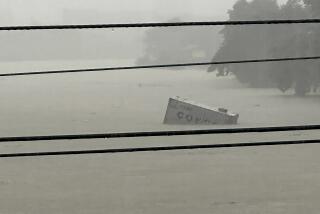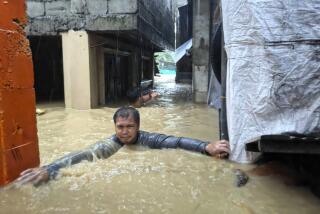Storm leaves 82 dead in northern Philippines and forecasters warn it may make a U-turn

Tropical Storm Trami blew away from the northwestern Philippines on Friday, leaving at least 82 people dead in landslides and extensive flooding that forced authorities to scramble for more rescue boats to save thousands of terrified people, who were trapped, some on their roofs.
But the onslaught may not be over: State forecasters raised the rare possibility that the storm — the 11th and one of the deadliest to hit the Philippines this year — could make a U-turn next week as it is pushed back by high-pressure winds in the South China Sea.
A Philippine provincial police chief said Friday that 49 people were killed, mostly in landslides set off by Trami, in Batangas province south of Manila. That brought the overall death toll from the storm to at least 82.
Eleven other villagers remain missing in Batangas, Col. Jacinto Malinao Jr. told the Associated Press by telephone from the lakeside town of Talisay, where he stood beside a villager whose wife and child were buried in the deep mound of mud, boulders and trees.
With the use of a backhoe and shovels, police scrambled to dig into 10 feet of mud, rocks and debris and found a part of a head and foot that apparently were those of the missing woman and child.
“He’s simply devastated,” Malinao said of the villager, a fisherman who was away tending fish cages in a lake when the landslide happened Thursday amid torrential rain.
“He’s in shock and couldn’t speak, and we’re only asking him to point to where their bedroom was located so we can dig in that part,” Malinao said.
The storm was last tracked Friday afternoon blowing 255 miles west of the northwestern Philippine province of Ilocos Sur with sustained wind gusts of up to 78 mph. It was moving northwest toward Vietnam, which is forecast to be lashed by Trami starting Sunday.
The Philippine weather agency, however, said it’s possible that high-pressure winds and other weather factors in the South China Sea could force the storm to turn back toward the Philippines.
President Ferdinand “Bongbong” Marcos Jr., sounding exasperated, inquired about that prospect in an emergency meeting with Cabinet members and disaster-response officials Friday about the response to the widespread devastation.
“What is the forecast for that? Is it possible it would return?” Marcos asked.
A government forecaster told him Trami could turn toward the western Philippines early next week, but its more likely to blow away from the Philippines again without making landfall.
“It doesn’t have to make landfall for the damage to occur,” Marcos said.
State forecaster Jofren Habaluyas told the AP that Trami’s possible U-turn has drawn interest among government weather experts in Asia, including those from Japan, which has been providing information to the Philippines to help track the storm.
The 82 storm deaths included 26 villagers who died in floods and landslides in hard-hit Bicol, an agricultural region and tourism destination southeast of Manila that is popular for Mayon, one of the country’s 24 most active volcanoes that has a near-perfect cone.
At least 27 remain missing in several provinces, including 17 in Batangas, according to Malinao and the Office of Civil Defense.
Although Trami did not strengthen into a typhoon, it dumped unusually heavy rains in some regions, including some that saw one to two months’ worth of rainfall in just 24 hours, inundating communities with flash floods.
Officials in Naga city, where 11 people died by drowning, and the outlying provinces of Camarines Sur and Albay pleaded for more rescue boats at the height of the onslaught to reach people trapped on the upper floors of their homes or on their roofs as floodwaters rose.
In the foothills of Mayon volcano in Albay province, mud and other debris cascaded toward nearby towns as the storm hit, engulfing houses and cars in black mud.
More than 2.6 million people were affected by the deluge, with nearly 320,000 fleeing to evacuation centers or relatives’ homes, officials said.
The government shut down schools and government offices for the third day on Friday on the main northern island of Luzon. Inter-island ferry services were also suspended, stranding thousands.
In Vietnam, state forecasters warned of heavy rains in the central region. Prime Minister Pham Minh Chinh ordered coastal provinces to stay vigilant, closely monitor Trami’s course and brace for contingencies.
Last month, Typhoon Yagi battered Vietnam, killing 323 people and causing extensive damage valued at $3.3 billion, according to a Vietnamese government report.
Each year, about 20 storms and typhoons batter the Philippines, a Southeast Asian archipelago that lies between the Pacific Ocean and the South China Sea. In 2013, Typhoon Haiyan, one of the strongest recorded tropical cyclones, left more than 7,300 people dead or missing and flattened entire villages.
Gomez and Dinh write for the Associated Press. Dinh reported from Hanoi, Vietnam.
More to Read
Sign up for Essential California
The most important California stories and recommendations in your inbox every morning.
You may occasionally receive promotional content from the Los Angeles Times.









